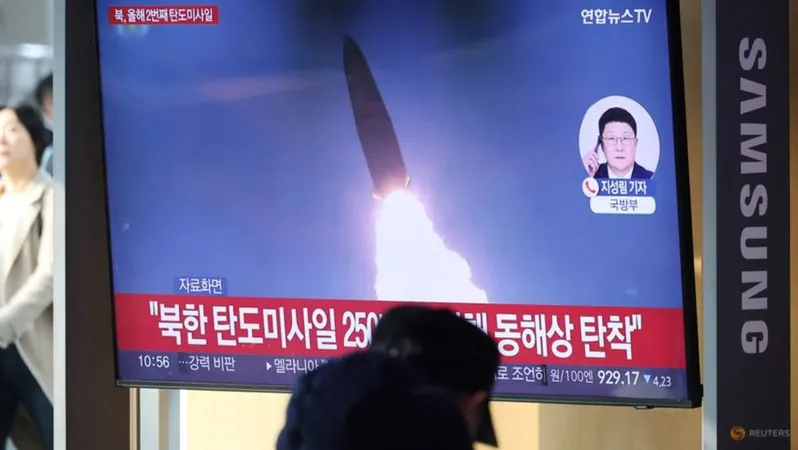
North Korea Launches Ballistic Missiles as Trump Prepares for Resurgence
2025-01-14
Author: Sarah
SEOUL: North Korea has intensified regional tensions by firing a series of short-range ballistic missiles into the East Sea on Tuesday, January 14. This provocative act comes just days before Donald Trump is set to return as U.S. President, leading experts to speculate whether this was a deliberate signal to the incoming administration.
The missile launch occurred while Japanese Foreign Minister Takeshi Iwaya was in South Korea for high-level discussions aimed at enhancing bilateral relations as regional dynamics shift with Trump's imminent return to the Oval Office. The South Korean military reported detecting multiple missiles fired from North Korea’s Ganggye area, which traveled approximately 250 kilometers before splashing down in the sea.
Both South Korean and U.S. intelligence agencies had foreseen the possibility of this launch, confirming that they were closely monitoring North Korea's missile preparations and maintaining a robust security posture. The U.S. Indo-Pacific Command condemned the missile test, urging North Korea to cease its "unlawful and destabilizing acts," while Seoul’s interim leadership, represented by acting president Choi Sang-mok, characterized the launch as a breach of United Nations Security Council resolutions.
Experts suggest that North Korea’s actions may be attempt to exert pressure on the new Trump government, with Yang Moo-jin, president of the University of North Korean Studies, emphasizing this could reflect a strategic move to enhance Pyongyang's bargaining power. Ahn Chan-il, a North Korea defector and researcher, supports this view, suggesting the tests are also designed to destabilize South Korea amidst political turmoil following President Yoon Suk Yeol's impeachment proceedings.
Remarkably, this missile launch marks the second such test in January alone, following an announcement from North Korea regarding a new hypersonic missile system that was launched just a week earlier. The specific site of this test was not disclosed; however, North Korean state media released images showcasing Leader Kim Jong Un supervising the hypersonic test alongside his daughter, Ju Ae.
The missile technology discussed includes a purported “new compound of carbon fiber” in the engine design, potentially allowing North Korea to target locations previously unattainable by their arsenal—a sophisticated approach that aligns them with military technologies seen in powers like the U.S., Russia, and China.
Relations between North and South Korea have reached a nadir, especially after a barrage of ballistic missile tests by the North last year in open defiance of international sanctions. In response, South Korea’s Defense Acquisition Program Administration (DAPA) announced the development of an advanced missile defense system aimed at intercepting the increasing missile and nuclear threats from the North. This new system comes with an estimated cost of 567.7 billion won (approximately $388 million) and is planned for completion by 2028.
Adding complexity to the situation, U.S. Secretary of State Antony Blinken, during a visit to South Korea last week, noted North Korea's deepening ties with Moscow, highlighting increased collaboration on advanced space technology. Experts believe this may also encompass the potential export of missile systems to Russia, which could then be utilized in the ongoing conflict in Ukraine.
Speculation continues regarding North Korea's military involvement in Ukraine, with reports indicating that Pyongyang might have sent thousands of troops to support Russian efforts—a claim neither nation has formally acknowledged. As the geopolitical landscape evolves, all eyes will remain on how the U.S. under Trump responds to North Korea's increasingly bold provocations.
 Brasil (PT)
Brasil (PT)
 Canada (EN)
Canada (EN)
 Chile (ES)
Chile (ES)
 Česko (CS)
Česko (CS)
 대한민국 (KO)
대한민국 (KO)
 España (ES)
España (ES)
 France (FR)
France (FR)
 Hong Kong (EN)
Hong Kong (EN)
 Italia (IT)
Italia (IT)
 日本 (JA)
日本 (JA)
 Magyarország (HU)
Magyarország (HU)
 Norge (NO)
Norge (NO)
 Polska (PL)
Polska (PL)
 Schweiz (DE)
Schweiz (DE)
 Singapore (EN)
Singapore (EN)
 Sverige (SV)
Sverige (SV)
 Suomi (FI)
Suomi (FI)
 Türkiye (TR)
Türkiye (TR)
 الإمارات العربية المتحدة (AR)
الإمارات العربية المتحدة (AR)